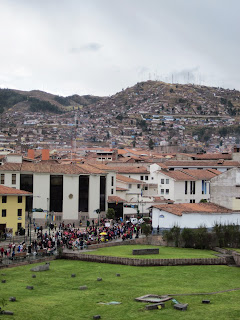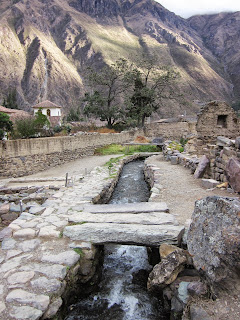On the recommendation of a friend (h/t Megan!), we decided to stay in Ollantaytambo instead of Aguas Calientes on our way up to Machu Picchu. Best. decision. ever.
We took a collectivo bus over from Cusco, and even just dropping 2k ft in altitude felt amazing (I'm a total altitude wimp). Ollanta is the most adorable town. It was built in it's current structure by the Incas (after they razed the town that had been there before), and the town's fortress is where the Incas retreated after the Spanish drove them out of Cusco. The Incas also built the extensive terracing that are now defining features of this valley as well. Part of the town is narrow walking roads, and the rest is accessible by car:
The Plaza de Armas surrounded by the mountains:
We decided to head over to see the fortress before we lost the day's light. It was CRAZY busy. (Aided I'm sure by all the travelers stuck in Ollanta because the train to Machu Picchu was shut down for the day due to an earthquake that caused a landslide to destroy part of the track.)
Climbing up the fortress steps actually ended up being a nice preview to Machu Picchu the next day.
The top of the fortress wasn't accessible to us, but you can see why they chose this as a defensive point. Horses wouldn't do you much good when you are storming this:
And the view from the top was great, looking over Ollanta and down the valley.
Below the fortress were old religious structures, complete with the Incan aquaduct system.
The trail along the ridge will eventually connect you with the beginning of the Inca Trail:
Part of what made Ollanta so gorgeous was the way the light constantly shifted as the clouds moved over the valley. One minute, you couldn't see the tops of the mountains...
And the next, they were basically sun soaked. This is also an example of the Inca aquaduct system that ran through the town.
On the opposite side of the town is another structure cut into the rock mountain. It was originally thought to be a prison, but it was later decided to be a grainery. In what seems to be further evidence to their love of stairs that they decided to put the grainery in such an inacccessible place accessible only by lots of stairs.
All in all, the town was incredibly charming, despite it's strong presence of tourists on their way up to Machu Picchu. There was SO much artesania available and the vendors were by far the most pleasant that I have dealt with since being here. I spent a fair amount on stuff, but I still feel like I should have bought more, seeing many of the same pieces of jewelry and sweaters sell for a lot more in even Cusco and Lima.
We timed our visit with the full moon, so we were treated to some gorgeous views as we said goodbye.





















